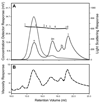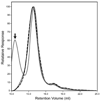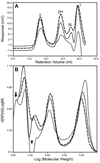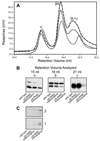Mechanism of insolubilization by a single-point mutation in alphaA-crystallin linked with hereditary human cataracts
- PMID: 18700785
- PMCID: PMC2642957
- DOI: 10.1021/bi800594t
Mechanism of insolubilization by a single-point mutation in alphaA-crystallin linked with hereditary human cataracts
Abstract
AlphaA-crystallin is a small heat shock protein that functions as a molecular chaperone and a lens structural protein. The R49C single-point mutation in alphaA-crystallin causes hereditary human cataracts. We have previously investigated the in vivo properties of this mutant in a gene knock-in mouse model. Remarkably, homozygous mice carrying the alphaA-R49C mutant exhibit nearly complete lens opacity concurrent with small lenses and small eyes. Here we have investigated the 90 degrees light scattering, viscosity, refractive index, and bis-ANS fluorescence of lens proteins isolated from the alphaA-R49C mouse lenses and found that the concentration of total water-soluble proteins showed a pronounced decrease in alphaA-R49C homozygous lenses. Light scattering measurements on proteins separated by gel permeation chromatography showed a small amount of high-molecular mass aggregated material in the void volume which still remains soluble in alphaA-R49C homozygous lens homogenates. An increased level of binding of beta- and gamma-crystallin to the alpha-crystallin fraction was observed in alphaA-R49C heterozygous and homozygous lenses but not in wild-type lenses. Quantitative analysis with the hydrophobic fluorescence probe bis-ANS showed a pronounced increase in fluorescence yield upon binding to alpha-crystallin from mutant as compared with the wild-type lenses. These results suggest that the decrease in the solubility of the alphaA-R49C mutant protein was due to an increase in its hydrophobicity and supra-aggregation of alphaA-crystallin that leads to cataract formation. Our study further shows that analysis of mutant proteins from the mouse model is an effective way to understand the mechanism of protein insolubilization in hereditary cataracts.
Figures






Similar articles
-
Mechanism of small heat shock protein function in vivo: a knock-in mouse model demonstrates that the R49C mutation in alpha A-crystallin enhances protein insolubility and cell death.J Biol Chem. 2008 Feb 29;283(9):5801-14. doi: 10.1074/jbc.M708704200. Epub 2007 Dec 5. J Biol Chem. 2008. PMID: 18056999
-
Activation of the unfolded protein response by a cataract-associated αA-crystallin mutation.Biochem Biophys Res Commun. 2010 Oct 15;401(2):192-6. doi: 10.1016/j.bbrc.2010.09.023. Epub 2010 Sep 15. Biochem Biophys Res Commun. 2010. PMID: 20833134 Free PMC article.
-
AlphaA-crystallin R49Cneo mutation influences the architecture of lens fiber cell membranes and causes posterior and nuclear cataracts in mice.BMC Ophthalmol. 2009 Jul 20;9:4. doi: 10.1186/1471-2415-9-4. BMC Ophthalmol. 2009. PMID: 19619312 Free PMC article.
-
Effects of alpha-crystallin on lens cell function and cataract pathology.Curr Mol Med. 2009 Sep;9(7):887-92. doi: 10.2174/156652409789105598. Curr Mol Med. 2009. PMID: 19860667 Review.
-
Regulation of αA- and αB-crystallins via phosphorylation in cellular homeostasis.Cell Mol Life Sci. 2015 Nov;72(21):4127-37. doi: 10.1007/s00018-015-1996-x. Epub 2015 Jul 26. Cell Mol Life Sci. 2015. PMID: 26210153 Free PMC article. Review.
Cited by
-
In vitro interactions of histones and α-crystallin.Biochem Biophys Rep. 2018 Jun 1;15:7-12. doi: 10.1016/j.bbrep.2018.05.005. eCollection 2018 Sep. Biochem Biophys Rep. 2018. PMID: 30023439 Free PMC article.
-
Oxysterol Compounds in Mouse Mutant αA- and αB-Crystallin Lenses Can Improve the Optical Properties of the Lens.Invest Ophthalmol Vis Sci. 2022 May 2;63(5):15. doi: 10.1167/iovs.63.5.15. Invest Ophthalmol Vis Sci. 2022. PMID: 35575904 Free PMC article.
-
A knock-in mouse model for the R120G mutation of αB-crystallin recapitulates human hereditary myopathy and cataracts.PLoS One. 2011 Mar 18;6(3):e17671. doi: 10.1371/journal.pone.0017671. PLoS One. 2011. PMID: 21445271 Free PMC article.
-
p62 expression and autophagy in αB-crystallin R120G mutant knock-in mouse model of hereditary cataract.Exp Eye Res. 2013 Oct;115:263-73. doi: 10.1016/j.exer.2013.06.026. Epub 2013 Jul 18. Exp Eye Res. 2013. PMID: 23872361 Free PMC article.
-
Modeling congenital cataract in vitro using patient-specific induced pluripotent stem cells.NPJ Regen Med. 2021 Oct 1;6(1):60. doi: 10.1038/s41536-021-00171-x. NPJ Regen Med. 2021. PMID: 34599192 Free PMC article.
References
-
- Van Montfort R, Slingsby C, Vierling E. Structure and function of the small heat shock protein/alpha-crystallin family of molecular chaperones. Adv Protein Chem. 2001;59:105–156. - PubMed
-
- de Jong WW, Caspers GJ, Leunissen JA. Genealogy of the alpha-crystallin--small heat-shock protein superfamily. Int J Biol Macromol. 1998;22:151–162. - PubMed
-
- Andley UP. Crystallins in the eye: Function and pathology. Prog Retin Eye Res. 2007;26:78–98. - PubMed
-
- Litt M, Kramer P, LaMorticella DM, Murphey W, Lovrien EW, Weleber RG. Autosomal dominant congenital cataract associated with a missense mutation in the human alpha crystallin gene CRYAA. Hum Mol Genet. 1998;7:471–474. - PubMed
-
- Sax CM, Piatigorsky J. Expression of the alpha-crystallin/small heat-shock protein/molecular chaperone genes in the lens and other tissues. Adv Enzymol Relat Areas Mol Biol. 1994;69:155–201. - PubMed
Publication types
MeSH terms
Substances
Grants and funding
LinkOut - more resources
Full Text Sources
Medical
Molecular Biology Databases
Miscellaneous

